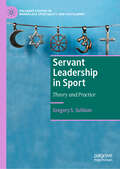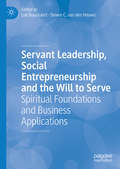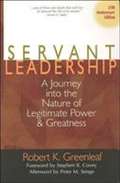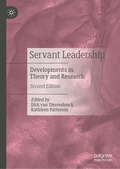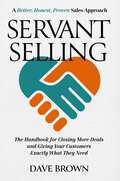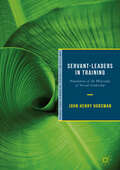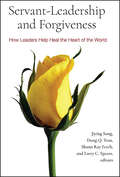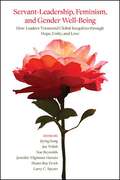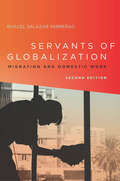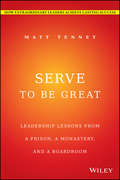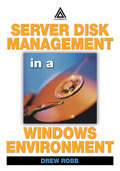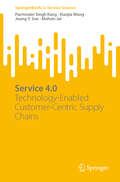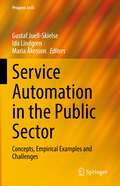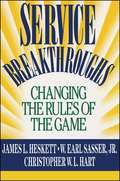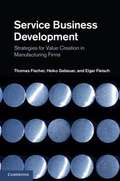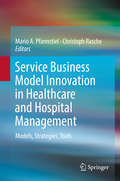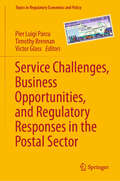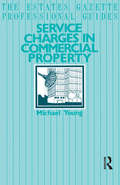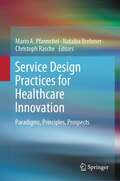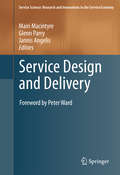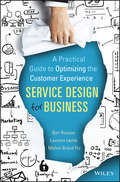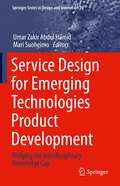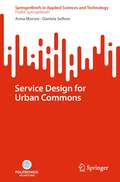- Table View
- List View
Servant Leadership in Sport: Theory and Practice (Palgrave Studies in Workplace Spirituality and Fulfillment)
by Gregory S. SullivanThis book applies the principles of well-being theory and positive psychology to sport to establish a basis of servant leadership in sport organizations. Though the win-at-all-cost mentality is pervasive in sport, leading to acceptance of leadership styles more associated with controlling and extrinsic motivators, the author proposes need satisfaction based on three psychological needs: autonomy, competence, and belongingness, which leads to enhanced job performance, job satisfaction, and well-being. Through need satisfaction, servant leaders positively influence organizational outcomes by enabling followers' growth and well-being. This book will make a new contribution to sport management research in applying the principles of positive psychology to servant leadership and to sport.
Servant Leadership, Social Entrepreneurship and the Will to Serve: Spiritual Foundations and Business Applications
by Luk Bouckaert Steven C. van den HeuvelThis book brings together a number of important essays on the intersection of servant leadership and social entrepreneurship, examining them through a shared focus on ‘the will to serve’. This combination bears out the insight that inspiring social and economic leaders are able to transform a conflictual human settlement into a collaborative and caring human community. The book seeks to answer the question of whether we can induce from their ‘way of doing things’ a model of civic entrepreneurship and leadership that can inspire people in profit, non-profit and public organizations. It also examines the extent to which the will to serve is compatible with the will to maximize profit or the will to gain economic, political or religious power. Furthermore, it asks how far different spiritual traditions create different models and examples of servant leadership and social entrepreneurship. This book will be of interest to researchers working in the fields of business ethics, business spirituality and corporate social responsibility.
Servant Leadership: A Journey into the Nature of Legitimate Power and Greatness
by Robert K. GreenleafIt work on leadership for business men and women, government leaders and all persons in positions of authority.
Servant Leadership: Developments in Theory and Research
by Dirk Van Dierendonck Kathleen PattersonIn the context of socially responsible business, hybrid working, demographic changes to the workforce and the renewed focus on employee well-being, the concept of the leader as servant has only continued in prominence. Indeed, servant leadership may be the answer to the demand for more ethical, people-centred leadership where working from humility with a focus on contribution are key elements. This second edition of the seminal text in the field provides a completely up-to-date overview of current thinking and empirical research on the determinants, underlying processes, and consequences of servant leadership. Updated throughout to reflect the current context, it includes new chapters covering the gender perspective on servant leadership, inner development goals, the servant-follower, and how to study servant leadership. A definitive resource for anyone studying or practicing servant leadership, this book provides a foundational approach that is rooted between theory and practice and takes a global approach to the topic.
Servant Selling: The Handbook for Closing More Deals and Giving Your Customers Exactly What They Need
by Dave BrownServant Selling offers a better—more honest—sales approach that will allow you to close more deals and serve your customers&’ needs. Will you walk away from a sale if it is not the best thing for your customer? Are you okay with losing a sale? As the top producer for an educational sales company, Dave Brown found himself wrestling with these questions during a summer of door-to-door sales. Then, one night, he found clarity: he could be fully honest and transparent and be the best at sales. In fact, being fully honest and transparent would make him the best at sales. In Servant Selling, Dave shares the tested and proven sales techniques he&’s mastered over his career. His proven strategy works for every demographic and in every industry—even with people who know nothing about sales. He will: Prepare you to serve by explaining the key components of servant selling and the foundations necessary to achieve success. Help you understand the service and sales cycle by focusing on the sales skills you need. Show you how to create concrete systems and utilize game-changing time management strategies to scale your success. Even more importantly, Dave shares the heart and mindset that makes his philosophy so successful: the servant-selling approach. By prioritizing your customer&’s needs, personality, preferences, and comfort above your sales goals, you will reach more people and make deeper, longer-lasting connections that will help you grow your business in an authentic and meaningful way.
Servant-Leaders in Training: Foundations of the Philosophy of Servant-Leadership (Palgrave Studies in Workplace Spirituality and Fulfillment)
by John Henry HorsmanGuided by and complimenting the writings of Robert K. Greenleaf, this book aims to deepen, expand and extend the philosophy of servant-leadership. Proposing a grounding framework for the studies of leadership, training and development, the author suggests that servant-leadership is primarily based on the structures of human development. Emphasizing the notion of a developing servant-consciousness and explaining the composition of a servant-leader disposition, this book analyzes the way that leadership has evolved. The characteristics of a servant-leader are categorized into five primary capacities, each with a focus on holistic listening and path-finding foresight. Servant-leaders in Training is essential reading for scholars of organizational leadership and management, and those wishing to gain a deeper understanding of servant-leader philosophy more generally.
Servant-Leadership and Forgiveness: How Leaders Help Heal the Heart of the World
by Jiying Song; Dung Q. Tran; Shann Ray Ferch; Larry C. SpearsIn a world where leaders and organizations face conflicts and complexity at an alarming rate, where human cruelty sometimes dominates kindness in individuals and families, and where nations hover in the shadow of moral and financial collapse, how do we find courage to forge a strong and enduring path into the future? In a fresh and profound approach to the personal, organizational, and global dynamic, discerning leaders consider the role of leadership and forgiveness in the midst of political and social upheaval. The epicenter of Servant-Leadership and Forgiveness speaks to leadership, the heart of the leader, and the power of forgiveness. It is a compilation of insightful, life-transformative, and significant essays on the nexus of servant-leadership and forgiveness in everyday life, the organizational world, and international contexts. The hope of the book is that people of all ages and creeds will engage in a deeper conversation around forgiveness and leadership, specifically servant-leadership, and reach greater personal and collective responsibility for leadership that helps heal the heart of the world through forgiveness.
Servant-Leadership, Feminism, and Gender Well-Being: How Leaders Transcend Global Inequities through Hope, Unity, and Love
by Jiying Song; Joe Walsh; Kae Reynolds; Jennifer Tilghman-Havens; Shann Ray Ferch; Larry C. SpearsIn a world where leaders and organizations face global pandemics and power conflicts, gender dualism still prevails, and gender stereotyping and the glass ceiling continue to affect humanity's conceptualizations of leadership. How can we integrate the lost aspects of ourselves, often socialized by gender, so as to recover wholeness? How can we discern and develop the feminine and masculine within every leader? Servant-Leadership, Feminism, and Gender Well-Being offers grace, strength, and hope by providing evidence of servant-leaders crossing gender boundaries and integrating gendered traits and behaviors. Feminist ways of knowing, honoring both feminine and masculine giftedness, deepen the holistic foundation of servant-leadership. By integrating female perspectives with male perspectives, a paradigm shift in leadership theory through avenues inherent to servant-leadership can move organizations from hierarchy-driven, rules-based, and authoritative models to value-driven, follower-oriented, and participative models.
Servants of Globalization: Migration and Domestic Work; Second Edition
by Rhacel Salazar ParreñasServants of Globalization offers a groundbreaking study of migrant Filipino domestic workers who leave their own families behind to do the caretaking work of the global economy. Since its initial publication, the book has informed countless students and scholars and set the research agenda on labor migration and transnational families.
Serve to Be Great
by Jon Gordon Matt TenneyDo you aspire to be a more effective leader who guides your team or organization to higher levels of lasting success? Would you like to look forward to each day and know that you are having a positive impact on the world around you?This is possible for everyone, regardless of your title or position. In fact, Serve to Be Great: Leadership Lessons from a Prison, a Monastery, and a Boardroom will train you to make this a reality. Although it's not an easy process, it is a worthwhile one.By making a shift in your approach to leadership, you can become a highly effective leader who enjoys your work and makes the world a better place. The shift is simply a matter of gradually becoming more focused on how you can serve others and increase your capacity to do so. Being an extraordinary leader does not require a MBA or PhD. The reality is that anyone can be a great leader.Author Matt Tenney has survived - and thrived - in situations where most people would have been quickly broken. In Serve to Be Great, he offers his life experiences and unique insights to help leaders apply the powerful principles of servant leadership. Servant leaders are not weak or timid. Motivated by the aspiration to serve, they achieve true power by empowering others to achieve excellence.This is a practical guide to becoming a leader people want to follow. By shifting focus from short-term gain to serving others, leaders can create great workplace cultures that deliver superior, long-term results. Serve to Be Great is the perfect playbook for realizing the ultimate in personal and business success.In keeping with the spirit in which Serve to Be Great was written, all author proceeds from the sale of the book will be donated to charity.
Server Disk Management in a Windows Environment
by Drew RobbHard drives and disk management receive scant attention from the industry press, yet recent surveys have identified disk failure as the #1 source of server downtime. Combine this fact with the skyrocketing TCO of data storage management, and it is apparent that server disk management is a subject deserving of much more scrutiny.Server Disk
Service 4.0: Technology-Enabled Customer-Centric Supply Chains (SpringerBriefs in Service Science)
by Parminder Singh Kang Xiaojia Wang Joong Y. Son Mohsin JatThis book presents a systematic framework for Service 4.0, including service digitization, digitalization, and digital transformation, which is an integral part of Supply Chain 4.0 in coping with complex, dynamic, and interdependent systems. It provides a comprehensive state-of-the-art review of digital technologies to support Service 4.0 and Supply Chain 4.0, and discusses important pillars of customer-centric supply chain models. It then explains the role of big data in customer-centric service-based supply chains and links the different types of data needed to promote end-to-end transparency and value co-creation activities to promote these key pillars. Moreover, the book introduces practical models to support analytics for customer-centric supply chains and sheds light on how the industry practically uses existing models to promote service co-creation. A chapter of a case study on women's clothing e-commerce reviews and demonstrates how various data visualization and text mining methods can be used to uncover meaningful insights within the review data. The book is intended to help students and researchers quickly navigate through various technologies and future research directions in the areas of Service 4.0 and Supply Chain 4.0. It is also a valuable read for practitioners in this field.
Service Automation in the Public Sector: Concepts, Empirical Examples and Challenges (Progress in IS)
by Ida Lindgren Gustaf Juell-Skielse Maria ÅkessonThis edited volume highlights the latest advances in and findings from research on service automation in public sector organizations. The contributing authors use a mix of social and technological approaches to increase readers’ understanding of public service automation. The respective chapters discuss the automation of services in public organizations from a conceptual standpoint, present empirical examples of automation applications in public organizations, and consider the implementation-related challenges that can arise. The book’s overall goal is to aid and inspire researchers and practitioners to expand their knowledge of service automation in public organizations, while also providing a foundation for policy development and future research. Following a brief introductory chapter, the book addresses major gaps in our current understanding of service automation in public organizations, and provides suggestions for future research. Moreover, it argues that there is a continued need to observe and learn from empirical examples, and a need for more critical studies on the social and societal consequences of increased service automation in public organizations.
Service Breakthroughs
by James L. Heskett W. Earl Sasser Christopher W. L. Hart Jr.What Do Citicorp, UPS and Marriott have in common? They are "breakthrough" service providers,firms that changed the rules of the game in their respective industries by consistently meeting or exceeding customer needs and expectations. To find out how these companies do it, service management experts James Heskett, Earl Sasser, and Christopher Hart put the question to the chief executive officers of fifteen of America's leading service firms attending a workshop at the Harvard Business School. Breakthrough leaders, they discovered, think very differently about their businesses than do their competitors, in distinct and well-defined ways. Now, in Service Breakthroughs, based upon five years of exhaustive research in fourteen service industries, Heskett, Sasser, and Hart show exactly what enables one or two companies in each industry to constantly set new standards for quality and value that force competitors to adapt or fail. At the heart of breakthrough performance, the authors contend, is a sometimes intuitive but thorough understanding of the "self-reinforcing service cycle" that replaces traditional management of "trade-offs." The "cycle" is a paradigm derived from the research results suggesting direct links between heightened customer satisfaction, increased customer retention, augmented sales and profit, improved quality and productivity, greater service value per unit of cost, improved satisfaction of service providers, increased employee retention, and further heightened customer satisfaction. With detailed examples and dramatic case studies of Mark Twain Bancshares, American Airlines, Florida Power & Light, Federal Express, McDonald's and many other companies, Heskett, Sasser, and Hart show how this self-reinforcing cycle of behavior differentiates breakthrough leaders from their "merely good" competitors. The authors describe how breakthrough managers develop counter-intuitive, even contrarian, strategic service visions. These companies define their "service concept" in terms of results achieved for customers rather than services performed. They target market segments by focusing on psychographics -- how customers think and behave -- instead of demographics. And instead of viewing a service delivery system as a facility where the service is produced and sold, breakthrough firms see it as an opportunity to enhance the quality of the service. These profound differences in thought and action have brought spectacular results. For managers who wish to set the pace in their service industries, Service Breakthroughs will be essential reading.
Service Breakthroughs
by James L. HeskettWhat Do Citicorp, UPS and Marriott have in common? They are "breakthrough" service providers, firms that changed the rules of the game in their respective industries by consistently meeting or exceeding customer needs and expectations. To find out how these companies do it, service management experts James Heskett, Earl Sasser, and Christopher Hart put the question to the chief executive officers of fifteen of America's leading service firms attending a workshop at the Harvard Business School. Breakthrough leaders, they discovered, think very differently about their businesses than do their competitors, in distinct and well-defined ways. Now, in Service Breakthroughs, based upon five years of exhaustive research in fourteen service industries, Heskett, Sasser, and Hart show exactly what enables one or two companies in each industry to constantly set new standards for quality and value that force competitors to adapt or fail. At the heart of breakthrough performance, the authors contend, is a sometimes intuitive but thorough understanding of the "self-reinforcing service cycle" that replaces traditional management of "trade-offs." The "cycle" is a paradigm derived from the research results suggesting direct links between heightened customer satisfaction, increased customer retention, augmented sales and profit, improved quality and productivity, greater service value per unit of cost, improved satisfaction of service providers, increased employee retention, and further heightened customer satisfaction. With detailed examples and dramatic case studies of Mark Twain Bancshares, American Airlines, Florida Power & Light, Federal Express, McDonald's and many other companies, Heskett, Sasser, and Hart show how this self-reinforcing cycle of behavior differentiates breakthrough leaders from their "merely good" competitors. The authors describe how breakthrough managers develop counterintuitive, even contrarian, strategic service visions. These companies define their "service concept" in terms of results achieved for customers rather than services performed. They target market segments by focusing on psychographics -- how customers think and behave -- instead of demographics. And instead of viewing a service delivery system as a facility where the service is producted and sold, breakthrough firms see it as an opportunity to enhance the quality of the service. These profound differences in thought and action have brought spectacular results. For managers who wish to set the pace in their service industries, Service Breakthroughs will be essential reading.
Service Business Development
by Heiko Gebauer Elgar Fleisch Thomas FischerHow can manufacturers of capital goods succeed in service business development? What are the potential network approaches for manufacturing companies planning on extending their service business? Over the last decade, the business environment of capital goods manufacturers has changed dramatically. Few capital goods manufacturers are able to outrun the competition with pure product-related technologies and innovation alone. For this reason they have added services to products as a way of responding to eroding margins and the loss of strategic differentiation through product innovation and technological superiority. Based on over twelve years of research, this book provides academics and business professionals with a thorough overview of the strategies available for value creation through service business development. It features case studies and covers a wide range of topics, including emerging issues such as service business in small and medium-sized companies, business innovation through services and the impact of rapidly growing Asian markets.
Service Business Model Innovation in Healthcare and Hospital Management
by Mario A. Pfannstiel Christoph RascheThis book demonstrates how to successfully manage and lead healthcare institutions by employing the logic of business model innovation to gain competitive advantages. Since clerk-like routines in professional organizations tend to overlook patient and service-centered healthcare solutions, it challenges the view that competition and collaboration in the healthcare sector should not only incorporate single-end services, therapies or diagnosis related groups. Moreover, the authors focus on holistic business models, which place greater emphasis on customer needs and put customers and patients first. The holistic business models approach addresses topics such as business operations, competitiveness, strategic business objectives, opportunities and threats, critical success factors and key performance indicators. The contributions cover various aspects of service business innovation such as reconfiguring the hospital business model in healthcare delivery, essential characteristics of service business model innovation in healthcare, guided business modeling and analysis for business professionals, patient-driven service delivery models in healthcare, and continuous and co-creative business model creation. All of the contributions introduce business models and strategies, process innovations, and toolkits that can be applied at the managerial level, ensuring the book will be of interest to healthcare professionals, hospital managers and consultants, as well as scholars, whose focus is on improving value-generating and competitive business architectures in the healthcare sector.
Service Challenges, Business Opportunities, and Regulatory Responses in the Postal Sector (Topics in Regulatory Economics and Policy)
by Timothy Brennan Pier Luigi Parcu Victor GlassThis edited volume includes original essays by prominent researchers and practitioners in the field of postal and delivery economics, originally presented at the 31st Conference on Postal and Delivery Economics held in Gdańsk, Poland, May 24-26, 2023. The book primarily examines the impact of digital platforms on the postal and delivery sectors, exploring the intricate regulatory challenges and competitive dynamics associated with this digital transformation. Other important topics include the regulation of parcels and their environmental footprint, in light of the innovations affecting the so-called last mile, and the effects of the COVID-19 pandemic on the postal sector, on both the global and local levels. Chapters also address postal costs, the funding of Universal Service Obligation (USO), and the related role of Universal Service Providers, especially in providing social services and facilitating digital inclusion. Finally, the impact of innovative technologies, such as AI, in the postal sector is discussed. This book is useful for graduate students and professors interested in postal and regulatory economics as well as postal administrations, consulting firms, and federal government departments.
Service Charges in Commercial Properties
by Michael YoungFirst Published in 1990. Routledge is an imprint of Taylor & Francis, an informa company.
Service Corp. International
by Benjamin C. Esty Craig F. SchreiberThe CFO of a high-growth company in the low-growth and fragmented funeral services industry must decide how to optimize capital structure and earnings growth while maximizing the company's market value.
Service Design Practices for Healthcare Innovation: Paradigms, Principles, Prospects
by Mario A. Pfannstiel Christoph Rasche Nataliia BrehmerThis book offers an overview of service design practices for healthcare and hospital management. It explores how these practices can help to generate innovations in healthcare and contribute to the improvement of patient-centered care. Respected experts, including scholars from various disciplines and practitioners from healthcare institutions, share essential insights into established research areas, fields of work and work structures, and discuss successful approaches, methods and tools. By illustrating innovative services, products, processes, systems, and technologies, as well as their application in practice, the authors highlight the role of participating stakeholders in service design projects and the added value that comes from sharing, communicating, networking and collaborating. This book is a must-read for scholars and practitioners in the hospital and healthcare sector. It will also appeal to anyone interested in organizational development, service business model innovation, customer involvement and perceptions, and service experience.
Service Design and Delivery
by Glenn Parry Jannis Angelis Mairi MacintyreService Design and Delivery provides a comprehensive overview of the increasingly important role played by the service industry. Focusing on the development of different processes employed by service organizations, the book emphasizes management of service in relation to products. It not only explores the complexity of this relationship, but also introduces strategies used in the design and management of service across various sectors, highlighting where tools, techniques and processes applicable to one sector may prove useful in another. The implementation methods introduced in the book also illustrate how and why companies can transform themselves into service organizations. While the book is primarily intended as a text for advanced-level courses in service design and delivery, it also contains theoretical and practical knowledge beneficial to both practitioners in the service sector and those in manufacturing contemplating moving towards service delivery.
Service Design for Business: A Practical Guide to Optimizing the Customer Experience
by Lavrans Løvlie Ben Reason Melvin Brand FluA practical approach to better customer experience through service design Service Design for Business helps you transform your customer's experience and keep them engaged through the art of intentional service design. Written by the experts at Livework, this practical guide offers a tangible, effective approach for better responding to customers' needs and demands, and provides concrete strategy that can be implemented immediately. You'll learn how taking a design approach to problem solving helps foster creativity, and how to apply it to the real issues that move businesses forward. Highly visual and organized for easy navigation, this quick read is a handbook for connecting market factors to the organizational challenge of customer experience by seeing your company through the customers' eyes. Livework pioneered the service design industry, and guides organizations including Sony, the British Government, Volkswagen Procter & Gamble, the BBC, and more toward a more carefully curated customer experience. In this book, the Livework experts show you how to put service design to work in your company to solve the ongoing challenge of winning with customers. Approach customer experience from a design perspective See your organization through the lens of the customer Make customer experience an organization-wide responsibility Analyze the market factors that dovetail with customer experience design The Internet and other digital technology has brought the world to your customers' fingertips. With unprecedented choice, consumers are demanding more than just a great product--the organizations coming out on top are designing and delivering experiences tailored to their customers' wants. Service Design for Business gives you the practical insight and service design perspective you need to shape the way your customers view your organization.
Service Design for Emerging Technologies Product Development: Bridging the Interdisciplinary Knowledge Gap (Springer Series in Design and Innovation #29)
by Umar Zakir Abdul Hamid Mari SuoheimoThe productization of emerging technologies related to the Fourth Industrial Revolution (FIR) is now getting more attention across different industries. Compared to the previous industrial transformations that the world has seen which relied on mechanical innovations, the ongoing FIR is seeing software and data-driven products as the foundation. Apart from that, topics such as circular and sustainable economy as well as climate change are also disrupting the industrial ecosystem. For a viable and successful productization of emerging technologies, collaborations between interdisciplinary stakeholders are a necessity. One of the elements that has been identified to facilitate this collaboration is service design. This book aimed to provide comprehensive service design discussions for practitioners in different fields and sectors. The aim is to bridge the knowledge gap between experts in academia, business and product development, among many others, to provide a unified understanding of the importance of service design for the productization of emerging technologies. The book consists of an overview of emerging technologies product development and service design, as well as perspectives from different sectors of the industry. The book is expected to benefit multi-disciplinary researchers, practitioners and general audiences with interests in Service Design for Emerging Technologies.
Service Design for Urban Commons (SpringerBriefs in Applied Sciences and Technology)
by Daniela Selloni Anna MeroniThis book explores the application of service design to urban commons. It originates from a project developed by the research group of POLIMI DESIS Lab of Politecnico di Milano, aimed at imagining the future of the Reggio Emilia Ducal Palace and its park - the Reggia di Rivalta. The peculiarity of the project lays in the idea that the design of a (public) space should be informed by the design of its services, because the development of specific activities actually builds a fundamental part of the identity of a place, conceiving both the tangible and intangible dimensions as part of a single creative process. The combination of a participatory process and the integration of spatial and service design led to infrastructuring a multi-stakeholder participatory action research of envisioning the future of a public good. This effort has been thus framed into a working methodology, specific tools and progressive outputs, which are defined as Service Master Planning (the process), and Service Master Plan (the product), allowing service design professionals to expand their knowledge and develop skills for a new field of application connected to urban planning.
